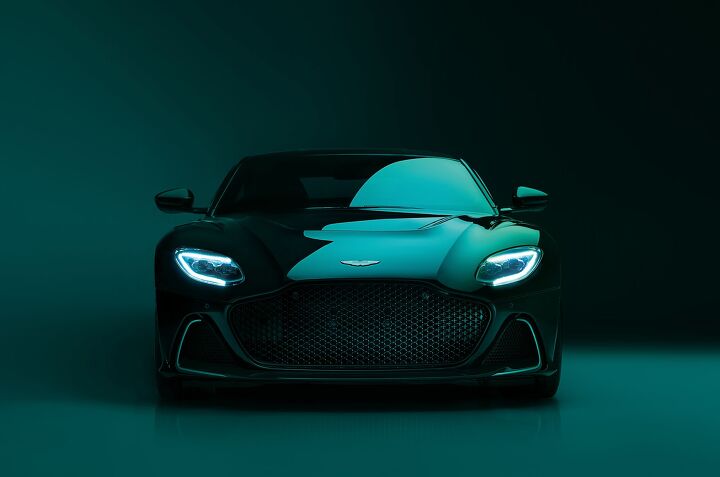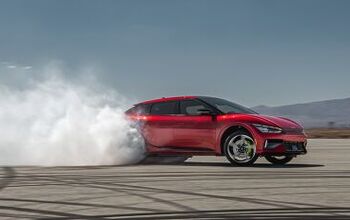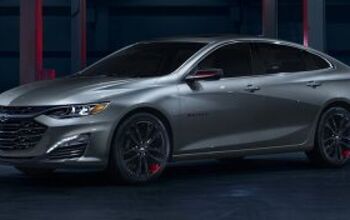Report: Aston Martin Actually Won’t Be Going All Electric

Despite previously having vowed to offer an entirely electric lineup by 2030, Aston Martin has decided to continue selling internal-combustion vehicles beyond the next decade. Company chairman Lawrence Stroll now believes that there will always be demand for combustion engines. Apparently, customers had conveyed to Aston dealers that they still prefer traditional powertrains and want the sensations associated with gasoline-powered automobiles.
Speaking with Autocar, Stroll said he intends for the brand to continue offering liquid-fueled vehicles for as long as governments allow. As things currently stand, the European Union has said it would provide exemptions for boutique manufacturers selling in extremely low volumes after 2035. But Aston Martin already moves too much metal, presumably requiring it to create a specialty subbrand selling a limited number of combustion vehicles each year.
Then again, EV sales aren’t anywhere near the industry or government regulators want them to be. Meanwhile, the public seems fed up with untenable regulatory schemes that are effectively steering the market in ways that don’t really advantage everyday consumers. While this fact hasn’t encouraged Western regulators to change course, it may be making opposition parties favoring deregulation more appetizing to voters.
None of this means Aston is abandoning electrification. While It has decided to delay the launch of its first electric vehicle by two years for a 2027 release date, it’s also increased its EV development budget. However, the company seems like it’s going to shift its focus toward plug-in hybrids — which may allow it to appease regulators while simultaneously satisfying its consumer base.
From Autocar:
Aston Martin has developed a bespoke EV architecture and plans to launch four electric cars on it – a GT, SUV, crossover and ‘mid-engined’ supercar – but they won't hit the market before 2027 after a reveal of the first model in late 2026.
"We have designed and ready one platform to take four different vehicles," Stroll told Autocar. "We have all the products technically engineered and physically designed.
“We planned to launch at the end of 2025 and were ready to do so, but it seems there is a lot more hype in EVs, politically driven or whatever, than consumer demand, particularly at an Aston Martin price point."
He added that demand for electric cars is particularly weak in the luxury segments, as Aston Martins were typically not 'first' cars for their customers and used more for leisure.
Stroll said Aston "will get there" with electric cars, "but at the previously [stated] date, definitely not"
Chairman Stroll made it very clear that he envisions hybrids as the path forward for Aston Martin. But it’s hard for that to mean anything after so many automakers spent the last decade telling the world how they’re on the cusp of a historic shift to totally electrified powertrains. What good is a promise from an industry that (with some exceptions) never seems to mean what it says?
For now, the company plans to focus on hybridizing its V8 powerplants because its customers tend to prefer them over V6s. The first example is supposed to be the mid-engined Valhalla (below) that’s slated to launch later this year. Subsequent models will see comprehensive refreshes the company claimed would include hybridization. Aston Martin believes it can set up vehicles to operate fully electric to traverse city centers that may have restrictions on combustion engines and then swap to hybrids where the gasoline and electric motors work together to maximize performance.
[Images: Aston Martin]
Become a TTAC insider. Get the latest news, features, TTAC takes, and everything else that gets to the truth about cars first by subscribing to our newsletter.
[Images: Aston Martin]

A staunch consumer advocate tracking industry trends and regulation. Before joining TTAC, Matt spent a decade working for marketing and research firms based in NYC. Clients included several of the world’s largest automakers, global tire brands, and aftermarket part suppliers. Dissatisfied with the corporate world and resentful of having to wear suits everyday, he pivoted to writing about cars. Since then, that man has become an ardent supporter of the right-to-repair movement, been interviewed on the auto industry by national radio broadcasts, driven more rental cars than anyone ever should, participated in amateur rallying events, and received the requisite minimum training as sanctioned by the SCCA. Handy with a wrench, Matt grew up surrounded by Detroit auto workers and managed to get a pizza delivery job before he was legally eligible. He later found himself driving box trucks through Manhattan, guaranteeing future sympathy for actual truckers. He continues to conduct research pertaining to the automotive sector as an independent contractor and has since moved back to his native Michigan, closer to where the cars are born. A contrarian, Matt claims to prefer understeer — stating that front and all-wheel drive vehicles cater best to his driving style.
More by Matt Posky
Latest Car Reviews
Read moreLatest Product Reviews
Read moreRecent Comments
- MRF 95 T-Bird Whenever I travel and I’m in my rental car I first peruse the FM radio to look for interesting programming. It used to be before the past few decades of media consolidation that if you traveled to an area the local radio stations had a distinct sound and flavor. Now it’s the homogenized stuff from the corporate behemoths. Classic rock, modern “bro dude” country, pop hits of today, oldies etc. Much of it tolerable but pedestrian. The college radio stations and NPR affiliates are comfortable standbys. But what struck me recently is how much more religious programming there was on the FM stations, stuff that used to be relegated to the AM band. You have the fire and brimstone preachers, obviously with a far right political bend. Others geared towards the Latin community. Then there is the happy talk “family radio” “Jesus loves you” as well as the ones featuring the insipid contemporary Christian music. Artists such as Michael W. Smith who is one of the most influential artists in the genre. I find myself yelling at the dashboard “Where’s the freakin Staple singers? The Edwin Hawkins singers? Gospel Aretha? Gospel Elvis? Early Sam Cooke? Jesus era Dylan?” When I’m in my own vehicle I stick with the local college radio station that plays a diverse mix of music from Americana to rock and folk. I’ll also listen to Sirius/XM: Deep tracks, Little Steven’s underground as well as Willie’s Roadhouse and Outlaw country.
- The Comedian I owned an assembled-in-Brazil ‘03 Golf GTI from new until ‘09 (traded in on a C30 R-Design).First few years were relatively trouble free, but the last few years are what drove me to buy a scan tool (back when they were expensive) and carry tools and spare parts at all times.Constant electrical problems (sensors & coil packs), ugly shedding “soft” plastic trim, glovebox door fell off, fuel filters oddly lasted only about a year at a time, one-then-the-other window detached from the lift mechanism and crashed inside the door, and the final reason I traded it was the transmission went south.20 years on? This thing should only be owned by someone with good shoes, lots of tools, a lift and a masochistic streak.
- Terry I like the bigger size and hefty weight of the CX90 and I almost never use even the backseat. The average family is less than 4 people.The vehicle crash safety couldn't be better. The only complaints are the clumsy clutch transmission and the turbocharger.
- MaintenanceCosts Plug in iPhone with 200 GB of music, choose the desired genre playlist, and hit shuffle.
- MaintenanceCosts Golf with a good body and a dying engine. Somewhere out there there is a dubber who desperately wants to swap a junkyard VR6 into this and STANCE BRO it.


































Comments
Join the conversation
This just in: Aston Martin may avoid insolvency after all.
If this is true then they won't go out of business. Good for them!